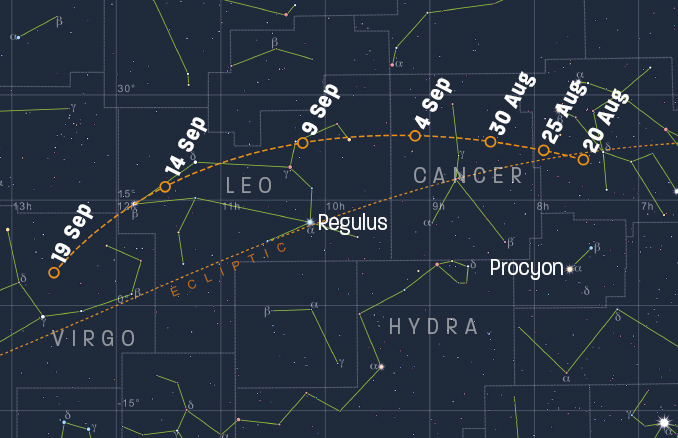It’s time to hold onto your observing hats once more as a new comet, C/2023 P1 (Nishimura), discovered on 11 August, promises a significant brightening as it hurtles towards the Sun. However, in typical cometary fashion, its behavior is difficult to predict on its first and only visit to the Sun’s harsh environs. There’s a possibility it may disintegrate and fade away.
Currently, Comet C/2023 P1 (Nishimura) can be found in the pre-dawn sky moving northeastward among the stars of Gemini. Observing reports are limited in the initial week or so, but it is shining at approximately magnitude +9.5. Upon discovery, it was reported with a coma of 5 arcminutes in angular size and a tail eight arcminutes long. Nishimura will be closest to Earth, at a distance of around 127.1 million kilometers (0.85 AU), on 13 September, and will reach perihelion on 18 September, when it will be 32.9 million kilometers (0.22 AU) from the Sun.

When to observe the comet
The comet remains visible in the pre-dawn sky until 13 September. A small telescope should easily spot it, provided your observing site has a good horizon to the east-southeast and is not heavily affected by light pollution. The Moon will not interfere until early September.
On 20 August at 4.25am, approximately 90 minutes before sunrise and at the start of nautical twilight from London (with the Sun 12° below the horizon), Comet C/2023 P1 (Nishimura) is positioned about 13° above, around 3° southeast of the magnitude +3.5 star Wasat (delta Geminorum). The comet should be more visible on the pre-dawn of 26 August, aligning nicely with Gemini’s bright stars Castor and Pollux, situated 6.7° below Pollux, the southern twin. It is now a bit higher in the sky, around 4° higher, with the Minor Planet Center anticipating a one-magnitude brightening.
By the end of August, Comet C/2023 P1 (Nishimura) is in Cancer, maintaining its altitude and positioned approximately 4° north-northwest of the Beehive cluster (Messier 44), the prominent open cluster. If it continues to brighten as predicted, the comet will shine at about magnitude +7.5.

Into September: losing altitude but brightening faster
In early September, Comet C/2023 P1 (Nishimura) begins to descend in altitude as it approaches the Sun, but compensates with an accelerated rate of brightening. It should still be observable through binoculars at this point.
On the morning of 7 September, the comet can be seen in Leo, passing north of magnitude +3 epsilon Leonis while positioned around 13° high in London at 5.05am. A few mornings later, Comet C/2023 P1 (Nishimura) drops below 10° altitude as it starts moving southward, now traversing the sky more than four times faster than during its discovery.
Into the early evening sky
Following its closest approach to Earth on 13 September, Comet C/2023 P1 (Nishimura) transitions to the early-evening sky, with an elongation from the Sun ranging between 12 to 15 degrees. There's a slight opportunity to catch a glimpse of it in strong twilight approximately 40 minutes after sunset from the 13th to the 18th, positioned just about 6° high in the west-northwest. Some estimates place Comet C/2023 P1 (Nishimura) at magnitude +2.8 during this time; even if accurate, it will be challenging to observe.
If it survives its perihelion passage, Comet C/2023 P1 (Nishimura) continues its southward descent for the remainder of the year. Observers in the Southern Hemisphere can witness it under twilit conditions. From Sydney, Australia, the comet appears low in the pre-dawn northeastern sky until around 25 August. After that, it becomes unobservable until late October, when it is low in the pre-dawn sky amidst the stars of Hydra, not far from the globular cluster M68. However, at this point, it shines fainter than magnitude +10.
 Comet C/2023 P1 (Nishimura) moves into the early evening sky starting on 13 June. It will be quite challenging to observe from UK skies, appearing low in the strong twilight, even though it may brighten to around magnitude +2 at perihelion. This scenario depicts the western-northwestern view from the south of England at 7.50pm BST, approximately 30 minutes after sunset.
Comet C/2023 P1 (Nishimura) moves into the early evening sky starting on 13 June. It will be quite challenging to observe from UK skies, appearing low in the strong twilight, even though it may brighten to around magnitude +2 at perihelion. This scenario depicts the western-northwestern view from the south of England at 7.50pm BST, approximately 30 minutes after sunset.
No comments:
Post a Comment